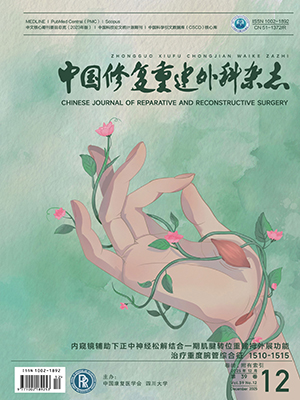| 1. |
?Robertsson O, Dunbar M, Pehrsson T, et al. Patient satisfaction after knee arthroplasty: a report on 27, 372 knees operated on between 1981 and 1995 in Sweden. Acta Orthop Scand, 2000, 71(3): 262-267.
|
| 2. |
Minoda Y, Iwaki H, Ikebuchi M, et al. Mobile-bearing prosthesis and intraoperative gap balancing are not predictors of superior knee flexion: a prospective randomized study. Knee Surg Sports Traumatol Arthrosc, 2014, 23(7): 1986-1992.
|
| 3. |
Dennis DA, Komistek RD, Scuderi GR, et al. Factors affecting flexion after total knee arthroplasty. Clin Orthop Relat Res, 2007, (464): 53-60.
|
| 4. |
Nicholis RL, Schirm AC, Jeffcote BO, et al. Tibiofemoral force following total knee arthroplasty: comparison of four prosthesis designsin vitro. J Orthop Res, 2007, 25(11): 1506-1512.
|
| 5. |
Meneghini RM, Ritter MA, Pierson JL, et al. The effect of the Insall-Salvati ratio on outcome after total knee arthroplasty. J Arthroplasty, 2006, 21(2): 116-120.
|
| 6. |
Bellemans J, Banks S, Victor J, et al. Fluoroscopic analysis of the kinematics of deep flexion in total knee arthroplasty. Influence of posterior condylar offset. J Bone Joint Surg (Br), 2002, 84(1): 50-53.
|
| 7. |
Ishii Y, Noguchi H, Takeda M, et al. Posterior condylar offset does not correlate with knee flexion after TKA. Clin Orthop Relat Res, 2013, 471(9): 2995-3001.
|
| 8. |
Ritter MA, Harty LD, Davis KE, et al. Predicting range of motion after total knee arthroplasty. Clustering, log-linear regression, and regression tree analysis. J Bone Joint Surg (Am), 2003, 85-A(7): 1278-1285.
|
| 9. |
Gandhi R, de Beer J, Leone J, et al. Predictive risk factors for stiff knees in total knee arthroplasty. J Arthroplasty, 2006, 21(1): 46-52.
|
| 10. |
Jeffcote B. The variation in medial and lateral collateral ligament strain and tibiofemoral forces following changes in flexion and extension gaps in total knee replacement. A laboratory experiment using cadaver knees. J Bone Joint Surg (Br), 2007, 89(11): 1528-1533.
|
| 11. |
Ismailidis P, Kuster MS, Jost B, et al. Clinical outcome of increased flexion gap after total knee arthroplasty. Can controlled gap imbalance improve knee flexion? Knee Surgery, Sports Traumatology, Arthroscopy, 2016. [Epub ahead of print].
|
| 12. |
Mihalko W, Krachow KA. Posterior cruciate ligament effects on the flexion space in total knee arthroplasty. Clin Orthop Relat Res, 1999, 360(360): 243-250.
|
| 13. |
Schnurr C, Eysel P, K?nig DP. Is the effect of a posterior cruciate ligament resection in total knee arthroplasty predictable? Int Orthop, 2011, 36(1): 83-88.
|
| 14. |
Kadoya Y, Kobayashi A, Komatsu T, et al. Effects of posterior cruciate ligament resection on the tibiofemoral joint gap. Clin Orthop Relat Res, 2001, 391(391): 210-217.
|
| 15. |
Mullaji A, Sharma A, Marawar S, et al. Quantification of effect of sequential posteromedial release on flexion and extension gaps: a computer-assisted study in cadaveric knees. J Arthroplasty, 2008, 24(5): 795-805.
|
| 16. |
劉璞, 蔡谞, 吳廈. 全膝關節置換術中切除后交叉韌帶和松解內側副韌帶淺層對關節間隙的影響. 解放軍醫學院學報, 2015, 36(5): 454-457, 476.
|
| 17. |
Baldini A, Scuderi GR, Aglietti P, et al. Flexion-extension gap changes during total knee arthroplasty: effect of posterior cruciate ligament and posterior osteophytes removal. J Knee Surg, 2004, 17(2): 69-72.
|
| 18. |
Okazaki K, Tashiro Y, Mizu-uchi H, et al. Influence of the posterior tibial slope on the flexion gap in total knee arthroplasty. Knee, 2014, 21(4): 806-809.
|
| 19. |
Takayama K, Matsumoto T, Muratsu H, et al. The influence of posterior tibial slope changes on joint gap and range of motion in unicompartmental knee arthroplasty. Knee, 2016, 23(3): 517-522.
|
| 20. |
王曉峰, 陳百成, 師晨霞, 等. 增加脛骨平臺后傾角度、后交叉韌帶部分松解對全膝關節置換術后膝關節運動影響的實驗研究. 中華外科雜志, 2007, 45(12): 839-842.
|
| 21. |
Nowakowski AM, Kamphausen M, Pagenstert G, et al. Influence of tibial slope on extension and flexion gaps in total knee arthroplasty: increasing the tibial slope affects both gaps. Int Orthop, 2014, 38(10): 2071-2077.
|
| 22. |
Tsukeoka T, Tsuneizumi Y, Lee TH. The effect of a sagittal cutting error of the distal femur on the flexion-extension gap difference in total knee arthroplasty. J Arthroplasty, 2013, 28(7): 1099-1102.
|
| 23. |
Minoda Y, Nakagawa S, Sugama R, et al. Intraoperative assessment of midflexion laxity in total knee prosthesis. Knee, 2014, 21(4): 810-814.
|
| 24. |
Hanaouchi T, Yamamoto K, Ando W, et al. The intraoperative gap difference (flexion gap minus extension gap) is altered by insertion of the trial femoral component. Knee, 2012, 19(5): 601-605.
|
| 25. |
Meister BR, Micheal SP, Moyer RA, et al. Anatomy and kinematics of the lateral collateral ligament of the knee. Am J Sports Med, 2000, 28(6): 869-878.
|
| 26. |
Harfe DT, Chuinard C, Espinoza LM, et al. Elongation patterns of the collateral ligaments of the human knee. Clinical Biomechanics (Bristol, Avon), 1998, 13(3): 327-330.
|
| 27. |
Martin JW, Whiteside LA. The influence of joint line position on knee stability after condylar knee arthroplasty. Clin Orthop Relat Res, 1990, (259): 146-156.
|
| 28. |
Watanabe T, Muneta T, Sskiya I, et al. Intraoperative joint gaps affect postoperative range of motion in TKAs with posterior-stabilized prostheses. Clin Orthop Relat Res, 2013, 471(4): 1326-1333.
|
| 29. |
Higuchi H, Hatayama K, Shimizu M, et al. Relationship between joint gap difference and range of motion in total knee arthroplasty: a prospective randomised study between different platforms. Int Orthop, 2009, 33(4): 997-1000.
|
| 30. |
Song SJ, Detch RC, Maloney WJ, et al. Causes of instability after total knee arthroplasty. J Arthroplasty, 2014, 29(2): 360-364.
|
| 31. |
Parratte S, Pagnano MW. Instability after total knee arthroplasty. J Bone Joint Surg (Am), 2008, 90(1): 184-194.
|




